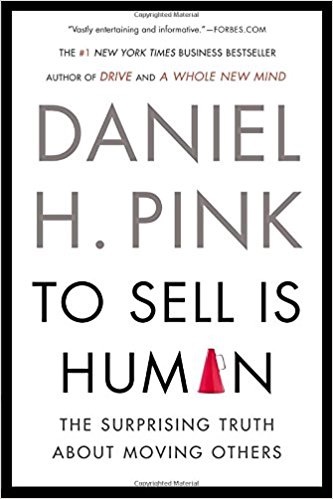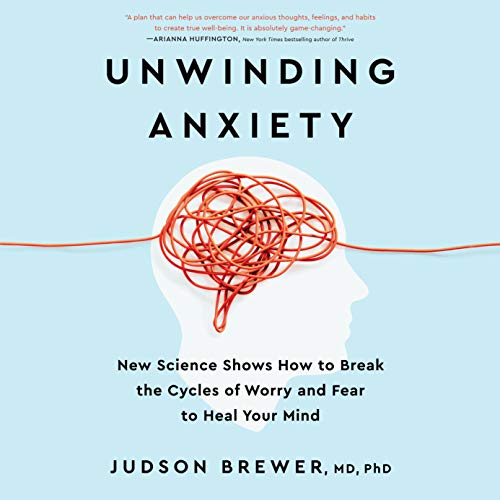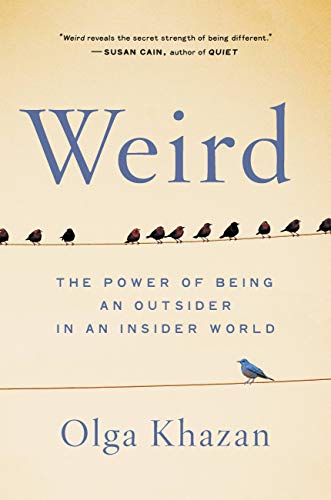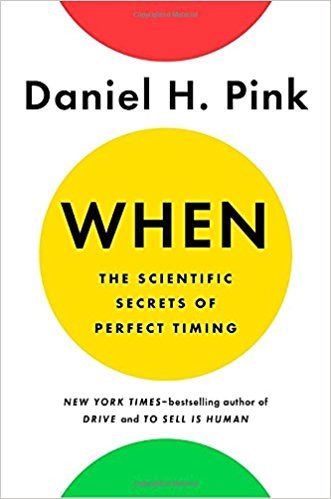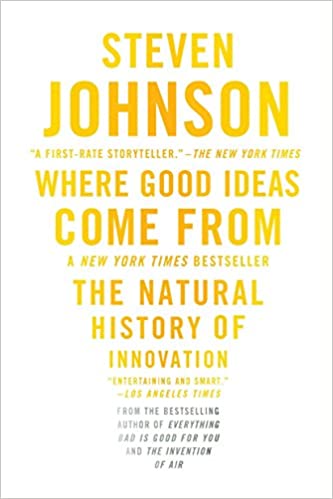Archive for the ‘Business Books’ Category
Sunday, January 6th, 2013
To Sell Is Human: The Surprising Truth About Moving Others by Daniel Pink is a fresh look at the art and science of selling, which is something we all do. If you want to better understand others’ perspectives, make your message clearer and more persuasive. Click below to purchase this book. It is purposeful and practical and may change how you see the world as it transforms what you do at work, at school, and at home.
Introduction
- Over the years, people in sales have often been seen as intellectual lightweights and dodgy characters. Even though 9% of us work in direct sales, some view it as the white-collar equivalent of cleaning toilets. The truth is, however, we are all involved in sales. We are all constantly trying to persuade, convince, and influence others. Studies show that collectively we are devoting 40% of our time on the job trying to move others. Even people in education and medical fields (Ed-Med), which are part of the fastest growing industries, engage in sales-like activities every day. As a result, non-sales selling is far more prevalent than selling in a traditional sense. People also consider this one of the most critical components in their professional success.
Entrepreneurship, Elasticity, and Ed-Med
- Entrepreneurs understand that segmenting job functions doesn’t always work. As small businesses proliferate, more people must have an elastic skill set, which includes a sales component. The U.S. even has more than twenty-one million people who are self-employed and therefore, have to sell themselves, and this number is growing. The Internet has knocked down barriers to entry by small operations. For example, the number of Etsy online shops is approaching one million. Kickstarter has helped people raise over $200 million to get projects off the ground, and smartphones can accept credit cards anywhere. Even bigger businesses are getting flattered with fewer people doing more varied things.
Ed-Med
- Jobs in education and medical care have increased from about 15% to 20% in the last twelve years. In the same time manufacturing jobs have gone from 17% to 12%. Ed-Med jobs are both intent on moving people as in changing what they know, think, and do. Teachers must convince students to part with time, attention, and effort as they sell a lesson. The same happens in health care as practitioners promote healthier behaviors. In any case, you have a better chance of moving someone if the proposed movement is in line with their personal goals. Letting kids choose what to write about and telling patients that you need to tap their expertise regarding their own bodies are examples of ways to move people.
From Caveat Emptor to Caveat Venditor
- Thanks to the abundance of information available on the Internet, today’s buyer has virtually as much information as today’s seller. As a result, sellers are no longer likely to live up to the outdated stereotype that includes terms like pushy, slick, and sleazy. In a world of information parity, the seller (vendor) is more likely to be one who has to beware (caveat). In many cases, the buyer knows more than the seller about a product and pricing. The same thing happens in education and medicine where students and patients can do research and know things that teachers and physicians do not. In the past, smart people were less likely to go into sales. Today, intelligence and creativity are essential.
Tags: Daniel Pink, To Sell is Human
Posted in Book Summaries, Business Books, Education Books, Leadership Books | Comments Off on To Sell Is Human: The Surprising Truth About Moving Others by Daniel Pink
Saturday, January 25th, 2014
Uncharted: Big Data as a Lens on Human Culture by Erez Aiden & Jean-Baptiste Michel (© 2013, Riverside Books: NY, NY) explains how they use Google’s repository of 30 million digitized books to investigate human culture. Their analytical tool lets them see how words and phrases have come and gone over the years and what these trends can tell us about ourselves. As more data becomes available they see many positive and negative possibilities. This is one book you don’t want to miss. Click at the bottom of any page to get a copy of this important book.
Erez Aiden and Jean-Baptiste Michel
- Erez has a PhD from Harvard and MIT. After stints at Harvard and Google he joined the faculty of Baylor and Rice were he directs the Center for Genome Architecture. In 2009 he was named as one of the world’s top innovators under 35 and has received the Presidential Early Career Award for Scientists and Engineers.
- Jean-Baptiste is a French and Mauritian entrepreneur and scientist and the founder of Quantified Labs. He is an associate scientist at Harvard and a former visiting faculty member at Google. He has a PhD from Harvard, is a TED Fellow, and one of Forbe’s “30 Under 30” winners.
Posted in Book Summaries, Business Books, Education Books, Leadership Books | Comments Off on Uncharted: Big Data as a Lens on Human Culture by Erez Aiden & Jean-Baptiste Michel
Friday, November 24th, 2023
Unwinding Anxiety: New Science Shows How to Break the Cycles of Worry and Fear to Heal Your Mind by Judson Brewer offers actionable advice for anyone who suffers from anxiety. There is also a free app available that can further help make your life less stressful. Learn how you can use curiosity and kindness to your advantage. While I don’t suffer from anxiety, I know many people who do. If you are anxious, you need this book. It also makes a great gift for anxious friends and family. Thanks, Jud.
Introduction
- Judson has MD and PhD degrees which took eight years to complete. He then went on to a career as a psychiatrist doing research on anxiety. He found that anxiety is in and of itself a harmful habit. It hides in peoples’ bad habits and feeds other behaviors. When he realized this, due in part to his own panic attacks as a student, he was determined to “science the hell out of it,” to cite a Matt Damon quote from The Martian. During the last decade, his research has lead to excellent results in helping people quit smoking, overeating, and other bad habits with the help of smartphone apps. This book is intended to be a useful pragmatic guide to changing how you understand anxiety so that you can work with it effectively, and as a bonus, break your unhelpful habits and addictions.
Part 0 Understanding Your Mind: The Psychology and Neuroscience of Anxiety
1. Anxiety Goes Viral
- Anxiety is a feeling of worry, nervousness, or unease, typically about an imminent event or something with an uncertain outcome. Generalized Anxiety Disorder (GAD) is experienced by people who generally worry throughout the day. This usually results in poor sleeping habits. Other symptoms include edginess, restlessness, tiring easily, impaired concentration, irritability, and increased muscle aches. Specific phobias and obsessive-compulsive disorder also fall under anxiety diagnoses.
- Anxious parents are likely to have anxious kids. Uncertainty and lack of structure cause anxiety for many. It is tricky to diagnose as most people experience it to some degree. Worries about health, safety, finances, politics, and relationships are the top sources. COVID-19 has certainly added to our collective stress. People with GAD usually also suffer from depression or something else.
2. The Birth of Anxiety
- Anxiety and its close cousin panic are both born from fear. Ironically, fear’s main evolutionary function is helping us survive. Being afraid of dangerous situations and doing something about it is a good thing. The pre-frontal cortex (PFC) portion of our brain is where future scenarios get played out. It thinks slower than the reflexive part of our brain. When it doesn’t have enough information to predict the future it may start working on worst-case scenarios causing anxiety.
- Fear is an adaptive learning mechanism. Anxiety is maladaptive. Fear + Uncertainly = Anxiety. Without past experience or accurate information, it’s easy to turn on the worry switch. This is why fake news, which travels faster than real news, promotes anxiety. Our news media is more likely to give us stories that feed our anxiety than those that make us feel good. (Doug: If the news you watch makes you anxious, consider not watching it.) Anxiety is also contagious. Knowing this and that uncertainty triggers anxiety can help put you more at ease. It is possible to replace old habits like worry with habits that are more rewarding so stay tuned.
3. Habits and Everyday Addictions
- Most of us are addicted to something as addictions are not limited to things like hard drugs, alcohol, and tobacco. Compulsive behaviors like shopping and overeating also fall into this category. Our modern world has increased the likelihood of addictive habits as just about anything is much more available. The goal of the media is to increase clicks and eyeballs. Therefore they design not to inform, but to create addictive experiences. This starts with a Trigger, which is a thought or emotion. Next comes a Behavior like worrying. Finally, we have a Result or Reward such as avoidance or overplanning. Reinforcements and immediate availability are a dangerous formula for modern-day habits and addictions. This is how our brains work and this is important knowledge.
4. Anxiety as a Habit Loop
- Anxiety can act as a trigger that leads to the behavior of worrying. The result of this behavior can be feeling more anxious. That is the loop or cycle. While worrying usually doesn’t work, this doesn’t stop our brain from trying it again and again. Being aware of this is a good place to start. Judson and his team developed an app (Unwinding Anxiety) that they use to teach mindfulness to the subjects of their research. You can get a free trial or pay for the complete program. They used this app on doctors who do not get training on how to handle their emotions in medical school and found success with 63% of their subjects. First, you need to map out your anxiety. Then you tap into your brain’s reward system before you tap into your own neural capacities to step away from anxiety-producing habits.
Posted in Book Summaries, Business Books, Education Books, Leadership Books | Comments Off on Unwinding Anxiety: New Science Shows How to Break the Cycles of Worry and Fear to Heal Your Mind by Judson Brewer
Monday, April 6th, 2020
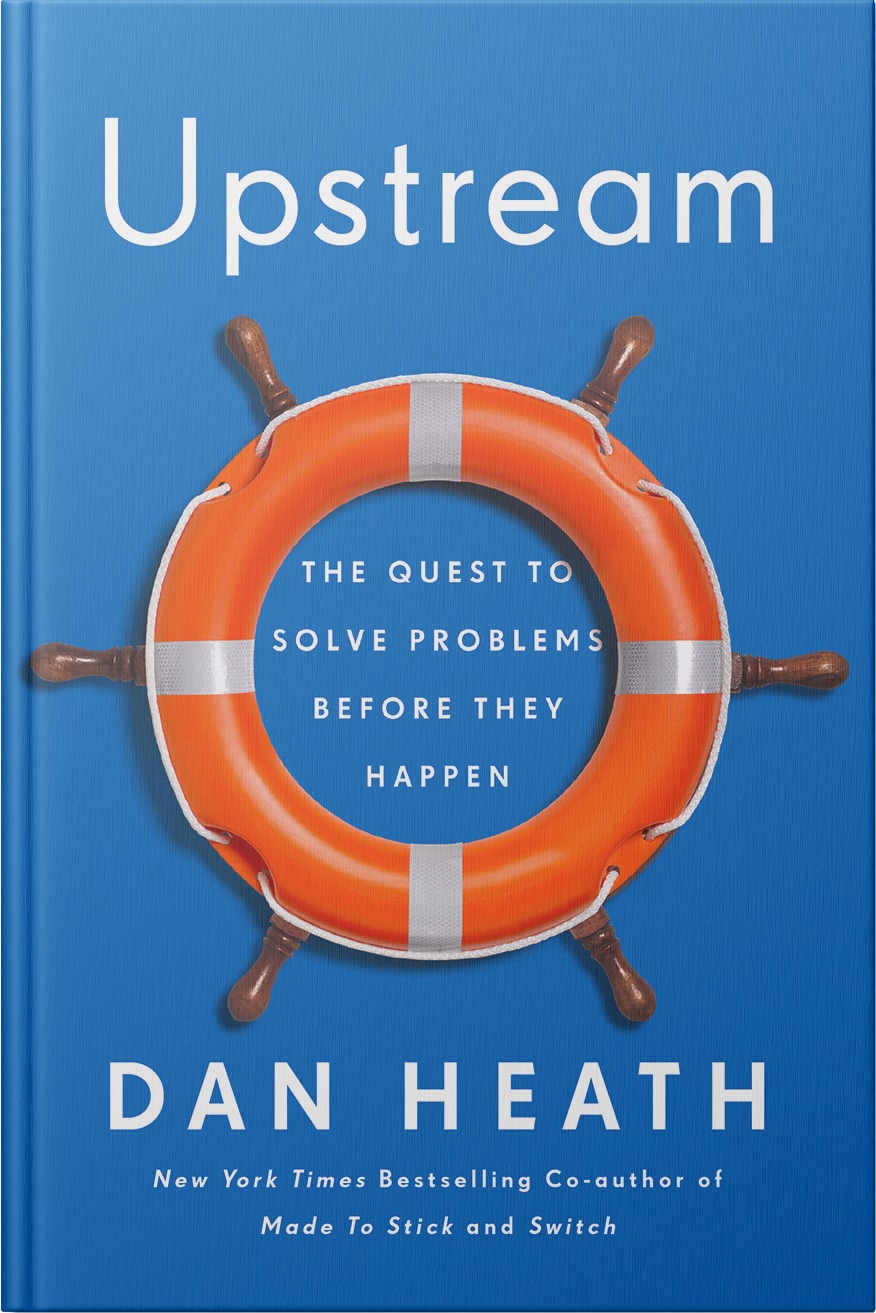
Upstream: How to Solve Problems Before They Happen by Dan Heath deals with the notion of preventing problems before they happen rather than being stuck with constantly fixing things after they break. He discusses barriers to Upstream thinking and offers questions Upstream leaders need to address. Whether you are a leader in your organization or just an ordinary individual trying to reduce stress and live a happier life, this book is a must.
1. Moving Upstream
- The book starts with a parable about two men rescuing drowning children who one after another come past them in a river. When one man stops the effort to head Upstream his friend asks what he is doing. The man says that he is going Upstream to tackle the man who is throwing the kids into the river. The key point is that Upstream efforts are aimed at preventing problems while Downstream efforts react to problems once they’ve occurred.
- An example is Expedia’s 58% call support rate. When they looked at the problem they found that none of their teams were judged on this number. Once they looked at the reasons for the calls it was easy to lower the rate to 15%. Another example compares one police officer who stands on the corner causing people to slow down and preventing accidents to another who hides and gives out tickets. Dan sees health care as one area where the US needs to shift to more Upstream efforts as other developed countries have done. The general goal in this book, therefore, is that we should all shift more of our energies Upstream.
Section 1 – The Three Barriers to Upstream Thinking
2. Problem Blindness
- Problem blindness happens when we believe that negative outcomes are natural and unavoidable. A successful example of fighting this problem happened in the Chicago Public Schools where the graduation rate in 1998 was 53%. They found that the key to graduation was a successful freshman year and a program to attack this problem was put in place. It involved teachers getting to know individual students better, giving more support, and collaborating with each other to help students in need. By 2018 the graduation rate had risen to 78%.
- Sometimes we miss problems because we focus on one thing and miss a problem in our peripheral vision. In the 1960s and 1970s, sexual harassment had been normalized in the workplace to the extent that women were encouraged to embrace it. In 1975 a journalist coined the term sexual harassment. Now that the problem had a name demanding a solution was an implied obligation.
- Another example relates to the extensive use of C-sections for child delivery in Brazil. They increased as they were convenient since they could be scheduled and they resulted in more money for the doctors. They also resulted in more babies ending up in intensive care as they were born sooner than necessary. Thanks to one woman and one doctor who saw the problem and took action, the C-section percentage is now coming way down.
3. A Lack of Ownership
- An example of this issue goes back to the Chicago Public Schools with its dismal graduation rate. It got that way because the adults saw it as the kids’ problem. It was greatly improved when the adults decided to make it their problem. There is a story here about a man who owned a carpet business. When he read about our environmental problems he decided to see what he could do. He motivated everyone in the company to look for ways to do things like recycling old carpets. When a doctor in Tennessee found out that more kids died inside cars than outside cars he went to work in 1976 on legislation requiring car seats for kids. By 1985 all 50 states had car seat laws. In short, upstream work is generally chosen rather than demanded. If you find yourself saying “it’s not my problem,” you are likely living downstream.
4. Tunneling
- When you are reacting to problems it can be like you are in a tunnel just digging forward. You don’t have time to step back and take a system-wide look at why the problem exists. Such time would be slack time and it is smart to build slack time for system thinking into your schedule. Poverty tends to cause more tunneling as it reduces bandwidth and causes stress. People who aren’t poor can solve some of their problems with money, which leaves more resources for the problems that money can’t solve. Dan gives examples of situations where tunneling gets in the way of upstream problem-solving.
Posted in Book Summaries, Business Books, Education Books, Leadership Books | Comments Off on Upstream: How to Solve Problems Before They Happen by Dan Heath
Friday, March 22nd, 2024
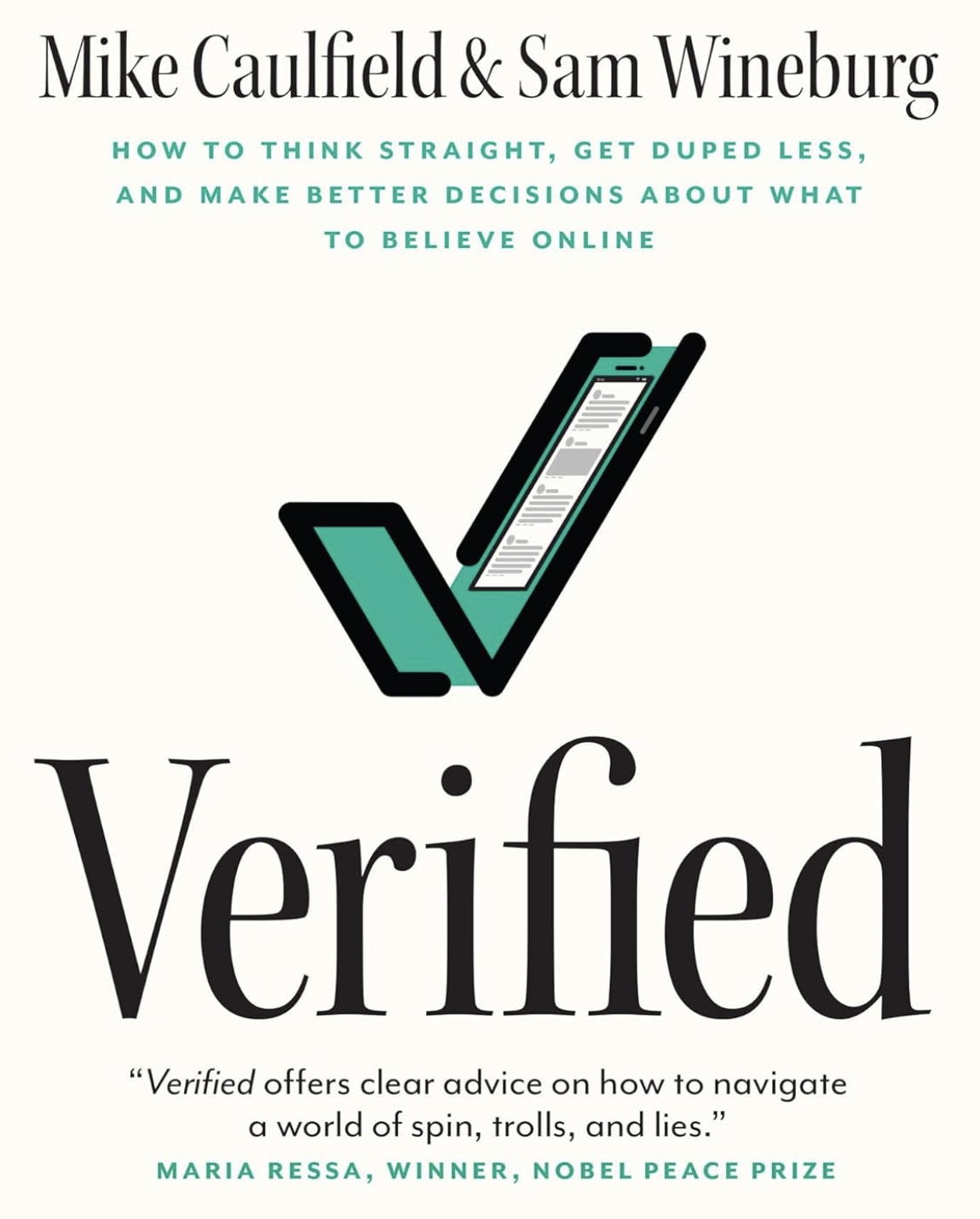
Verified: How to Think Straight, Get Duped Less, and Make Better Decisions About What to Believe Online by Mike Caulfield and Sam Wineburg should be the textbook for any course in high school and college that deals with verifying information on the Internet. Its lessons are easy to absorb and remember, which means that it lives up to its lofty title. Get your copy today.
Introduction
- Prior to the arrival of the Internet, the information we received was already processed by society’s gatekeepers and niche information was seldom available. The Internet was supposed to change all that. While we know that much of what we find on the Internet is false, the skills we inherited from the pre-Internet age are not much use in separating truth from fiction. This well researched book may not protect you from all errors of judgement, but it should make such errors fewer and farther between.
1. Get Quick Context: It Can Take as Little as Thirty Seconds, Seriously!
- Most hoaxes can be quickly disposed of with a simple Internet news search. As you face claims of fact there are three contexts that you should consider. They are the source, the claim itself, and your own level of expertise on the matter. As you reason about a specific piece of content there are certain things to do that involve the acronym SIFT. The first is STOP and ask what you know about the claim. Next INVESTIGATE the source to see if it’s trustworthy. Proceed to FIND other coverage. Finally, if possible, TRACE the claim to its original source. The authors give several examples and warn that just because a claim seems far fetched doesn’t mean that it is.
2. Cheap Signals: Or, How Not to Get Duped
- A cheap signal is one that costs little or nothing and is easy for any con artist to produce. Just because a website has a snazzy look and is well written means nothing. Some legitimate sites may not look totally professional. CRAAP is an acronym for the things you should consider as you evaluate a site. Currency deals with when the content was posted. Relevance deals with how the topic fits with what you are looking for. Authority deals with the credentials of the author. Accuracy means you can verify the information with another source. Purpose deals with the aim of the organization publishing the site.
- Even if a site passes all five CRAAP tests, it still may be a front for an industry promoting its products. It may be a wolf in sheep’s clothing. You should always read the URL of any new site you visit. It can help you spot imposters. The suffixes are important. Dot-com sites are supposed to be commercial and usually try to sell you something, but that is not always the case. (Doug: My site is a dot-com but I’m just providing free resources like this summary.) Dot-orgs are supposed to be non-profit organizations, but beware. Pretty much anyone can get a dot-org site. Also, beware of data bases where anyone can add a record.
3. Google: The Bestie You Thought You Knew
- In 2014 Google started putting descriptive search results at the top of the results page. They called it a featured snippet. Google says that they create the snippets from trusted sites based on the keywords in your search. They are very helpful when things are clear, but may not be when things are vague or complex. The keywords you select are important and you usually need several good ones in a search to get good results. Featured snippets may not provide the best answer.
- Google is not neutral. It tries to give you what you want. Try to avoid searches that broadcast your preferences. Choose neutral search terms that don’t contain words like good or bad. Try searching “are soda taxes a good idea” and “are soda taxes a bad idea” as a example of how this works.
Posted in Book Summaries, Business Books, Education Books, Leadership Books | Comments Off on Verified – Book Summary
Monday, December 7th, 2020
Weird: The Power of Being an Outsider in an Insider World by Olga Khazan is for anyone who has felt like they were different from typical people in their culture. Since we are all unique, we probably all feel different or weird from time to time. There are a number of research-based coping methods here that just about anyone can use. While this book is aimed at the general public, it is especially good for anyone doing counseling.
Part One: Being Weird
1. Weird
- Olga was a Russian Jewish immigrant who grew up in West Texas. The rest of the people in her town were either white evangelical Christians or immigrants from Mexico. Since Russian Jews were forced to be atheists, they don’t even fit in with American jews. Her feeling of weirdness was also fostered by the fact that her parents moved a lot and always to different school districts. At home, her parents watched only Russian television and ate only Russian food. She attended American University in Washington, D.C., which didn’t help her feel any less weird. After interviews with over three dozen successful “weird” people, she concluded that it can be good to be weird as it confers a hidden advantage. It also behooves you to live and work among weirdos. Groups are smarter and more powerful when their members hold a diversity of views and backgrounds.
2. The Realization
- Cultural norms are unwritten rules that make us think that “right” is what everyone else is doing. There is even a gene that predisposes people to be rule followers. People like it when others follow norms as they don’t like being surprised. Norms are inherently conservative and can get in the way of innovation and creativity. They also may not make sense, think neckties. Olga presents a review of how swimwear reveals the randomness of social norms.
- Next, we have short stories of two “weirdos.” The first is a gay male kindergarten/preschool supervisor. Only 2% of kindergarten teachers are men and a female NASCAR driver who represents a microscopic fraction of the total. Their problems aren’t the same, but they both have many more challenges to face than their peers.
- Friends are for comfort, taking it easy, relaxing, and not being challenged. By hanging out with people who are just like you, you can be out of touch with the big, beautiful, diverse world. Unfortunately, it’s difficult to find acceptance and friendship in an environment where you are the different one.
- Cultures can be tight or loose. In tight cultures, norms are strict and formal, and the punishments for breaking them can be severe. Loose cultures permit a wider range of behaviors. Weird people have an easier time in loose cultures. Tight countries like Russia are autocratic and have less free media. As you go from tight to loose cultures you go from orderliness to creativity. Rural cultures tend to be tight while urban cultures tend to be loose. The LGBTQ folks definitely need to find a loose culture to live in. People who travel between tight and loose cultures in either direction tend to be disoriented and feel weird. The stories of three more weirdos conclude this chapter.
3. The Exclusion
- Once humans formed groups intergroup conflict was sure to start. Rather than being inborn, prejudice is a reflection of the dynamics between groups. In our hunter-gather days, social relationships were the only wealth a person had. That predisposed them to take care of other group members. Successful groups look out for each other. Rulers, money, and organized religion created subgroups and pitted them against each other. Groups are based on their differences even when they are laughably minor (think protestants and Catholics in Northern Ireland). The idea that diversity can be a source of strength and advantage is a relatively recent concept.
- When it comes to differences, gender is a big one. Historically, women have had to put their own interests after their mate’s. They needed to take their cues from their husband’s mood in order to prosper. We can thank our brains for our ability to recognize differences as it seems to be automatic. The brain also stores stereotypes. Our instincts set us up to avoid or alienate people who don’t look like us. One outsider is a deviant. As the number grows they become a threat and cause a fear of losing status. Americans are more accepting of immigrants who speak English, while the Swiss are more accepting of people who get to work on time.
- People who have a problem with someone from a different group tend to generalize the issue to the entire group. Peripheral group members tend to marginalize someone else as pushing someone weirder to the side can make you feel normal. People who are more offended by norm violators are not likely to think outside of the box and be more creative. As a result, looser cultures are more creative. They are also sick less. Tight nations have fewer natural resources, worse air and water, more deaths from communicable diseases, and more natural disasters. Such collective threats foster tightness. Stories here include an Amish girl and an African Muslim immigrant girl.
Posted in Book Summaries, Business Books, Leadership Books | Comments Off on Weird: The Power of Being an Outsider in an Insider World by Olga Khazan
Friday, September 2nd, 2011
When You Come to a Fork in the Road, TAKE IT: Inspiration and Wisdom from One of Baseball’s Greatest Heroes by Yogi Berra, with Dave Kaplan (©2001, Hyperon: New York, NY) is funny, insightful, and inspirational all at once. I have always been a big fan of Yogi as he seems like such an unlikely hero. He doesn’t look like a star athlete and at first, his speech doesn’t sound like it contains a lot of wisdom. He was the son of poor immigrants and dropped out of school after the 8th grade. In spite of this be became an MVP and winner of a record ten world series. He was a successful manager and many of his quotations have become known throughout our culture. As this book shows, they are not just amusing. The quotes along with Yogi’s philosophy contain a lot of wisdom mixed in with the humor. Many apply very well to the field of education as I try to show here. There are a lot of pages, but they are short and good.
When You Come to a Fork in the Road, TAKE IT!
- Throughout life you come to serious forks in the road – decisions. No matter what decision you make, taking a job, getting married, buying a house, whatever it is, you shouldn’t look back. Trust your instincts. I’ve always done things that feel right. Learn from the choices you make and don’t second guess yourself.
- On big life decisions get all the advice you can. Talk it over with parents, a mentor, a teacher, or a coach. They’ve had more life experience. They have more miles on them and can help you get on the right path. A teacher once asked me, “Don’t you know anything?” I said I don’t even suspect anything.
Enjoy The Moment
- Nobody can help but be nervous in the World Series or at a job interview, or giving a presentation, or when you’re called on in class. You have to channel that nervousness. Enjoy the moment and make it a great experience. You need to learn to relax. You can’t be afraid of making a mistake. There’s always the next inning or the next day. Life goes on.
Nobody Did Nothin’ to Nobody
- There were many times I had to help my teammates so that bad things didn’t happen. When you’re part of a team you stand up for your teammates. Your loyalty is to them. You protect them through good and bad because they’d do the same for you.
Tags: Yogi Berra
Posted in Book Summaries, Business Books, Education Books, Leadership Books | Comments Off on When You Come to a Fork in the Road, TAKE IT by Yogi Berra, with Dave Kaplan – Great for Educators & Parents
Monday, February 12th, 2018
When: The Scientific Secrets of Perfect Timing by Daniel H. Pink takes on the hidden science of timing and how it impacts our lives. There is solid advice here that applies all of us at work, in school, and in our leisure time. Be sure to get your own copy and consider giving one or more as gifts. Also see my summaries of Dan’s other fine books Drive: The Surprising Truth About What Motivates Us and To Sell is Human: The Surprising Truth About Moving Others.
Introduction
- We all know that timing is everything, but we don’t know much about timing itself. Our lives present us with a never-ending stream of when decisions. Rather than being a how-to book, this is a when-to book. For content, Daniel and two other researchers analyzed more than seven hundred studies in the fields of economics, anesthesiology, anthropology, endocrinology, chronobiology, and social psychology to unearth the hidden science of timing. Get ready for a lot of science.
Part 1. The Day – 1. The Hidden Pattern of Everyday Life
- This chapter focuses on our biological clocks or circadian rhythms. The research assembled here shows that about two-thirds of us are morning people (larks), while the rest are more productive later in the day (owls). There is a test here that can help you figure out which one you are. The message here for bosses and teachers is that the type of work or problems you expect workers and students to engage in should be dependent on their chronotypes and the time of day. No matter which type you are, you are likely to experience peaks and troughs. At the end of this chapter is the first Time Hackers Handbook. Each chapter has its own version. Here Dan discusses when to exercise based on your goals and tips for a better morning.
2. Afternoons and Coffee Spoons: The Power of Breaks, the Promise of Lunch, and the Case for a Modern Siesta
- There is a lot of research that shows that we perform worse just prior to lunch or near the end of the day. The answer is to take periodic breaks away from your desk. This is especially true for low performing students. Breaks should involve movement and detachment from your work or study. Having conversations about non-work topics with others helps as does walking outside.
- Although we often hear that breakfast is the most important meal, it is not well supported by research. There is evidence that how you do lunch can make a difference. Unfortunately, too many people eat lunch at their desks. Like other breaks, your lunch break should involve moving to somewhere else and detachment from your job. Naps are also an excellent way to ramp up productivity, but not just any nap will do. The optimum length is between ten and twenty minutes. One way to promote this is to take caffeine in some form prior to your nap. It won’t kick in for about twenty-five minutes so it will help you get back in the game. Innovative companies are creating nap spaces for their employees.
- The hackers handbook here offers advice for schools. 1. Schedule recess before lunch. 2. Don’t structure recess. Let kids negotiate it themselves. 3. Include mid-morning and mid-afternoon breaks where students move about. 4. Make sure teachers get breaks too. 5. Do not deny recess as a consequence of bad behavior.
Posted in Book Summaries, Business Books, Education Books, Leadership Books | Comments Off on When: The Scientific Secrets of Perfect Timing by Daniel H. Pink
Tuesday, March 16th, 2021
Where Good Ideas Come From: The Natural History of Innovation by Steven Johnson tracks the innovation process through history and shows what ingredients promote a creative climate. From Darwin to the World-Wide-Web we see how individuals, networks, markets, and open-source projects have forged our modern world. Anyone interested in history and/or science should add this to their bookshelf. Every school and professional development library should too.
Introduction: Reef, City, Web
- We start with Darwin discovering that coral reefs can harbor uncountable numbers of species compared to the fewer life forms found in surrounding waters. Then we visit Kleiber’s law which states that the number of heartbeats per lifetime tends to be stable from species to species. Bigger animals just take longer to use up their quota and therefore live longer. When Geoffrey West investigated whether Kleiber’s law and applied it to cities he found that as cities get bigger, creativity per capita increases. Using data like R&D budgets and patents he found that a city ten times larger than its neighbor was seventeen times more innovative and a city fifty times bigger was 130 times more innovative. This is also true for the biological diversity of coral reefs.
- Here we meet the 10/10 rule which states that it takes about ten years for a new innovation to be developed and ten more years for it to be widely accepted. Innovations like color TV, HDTV, AM radio, Video Tape players, CD and DVD players, and GPS navigation all followed that rough time lime. The same was true for the graphical user interface on computers and most software like word processors and spreadsheets. Running counter to the 10/10 rule was Youtube. It went from idea to mass market in two years creating the 1/1 rule. Like YouTube, good ideas want to connect, combine, and cross conceptual borders. They want to complete each other as much as they want to compete.
1. The Adjacent Possible
- The idea for the original baby incubator happened when someone saw how baby chicks were kept warm at a zoo. When modern incubators costing $40,000 were sent to developing counties, however, they soon broke and no one knew how to fix them. An MIT professor named Timothy Prestero got the idea of building incubators using local technology and parts. Since locals in most developing countries could repair cars, he used spare auto parts and his invention was a great success. In many ways, our good ideas are constrained by the parts and skills that surround them.
- The concept of the adjacent possible states that in a given environment there are only so many new things that can be created. In Earth’s early atmosphere, for example, the simple molecules could only create so many more complex molecules, but as they did so further expansion became possible. This fairly describes how evolution works. It also explains why big cities and reefs are more innovative as there are more adjacent possibles. Throughout history, major inventions have happened in multiple places. This is because they couldn’t happen until the parts were available. The trick to having good ideas is to get more parts on the table.
2. Liquid Networks
- A good idea is a network of novel nerve connections and they wouldn’t happen if the nerve connections in our brain weren’t plastic and capable to changing. The new idea also has to be part of the adjacent possible. Since all you have to generate ideas are your genes and your environment, this explains why some environments generate more good ideas than others.
- After explaining why life is based on the connections of the carbon atom and the necessity of water, Steven extends the ideas of why cities produce innovations. A graphic shows the key innovations that occurred prior to the rise of cities and after and there is no contest even though cities haven’t been around that long compared to humans. The Italian Renaissance is an example of how cities and trade promote innovation. The excess wealth they created also promoted the arts.
- The studies of Kevin Dunbar in the early 1990s showed that ideas are more likely to emerge during meetings than in isolation. The results of one person’s reasoning out loud can become the inputs for another person’s reasoning. When people realized this they started designing buildings that would promote more interaction between people. Total open environments don’t seem to work as people don’t like them. The current idea is to have flexible environments where people can get together (conference rooms) and where people run into each other (water coolers). It’s also good to have multiple disciplines in the same building as innovations often happen at disciplinary boundaries.
Posted in Book Summaries, Business Books, Education Books, Leadership Books | Comments Off on Where Good Ideas Come From: The Natural History of Innovation by Steven Johnson
Wednesday, July 25th, 2012
Why Social Media Matters: School Communication in the Digital Age by Kitty Porterfield and Meg Carnes (© 2012, Solution Tree Press: Bloomington, IN) offers educators an explanation of why social media is an important powerful tool for communication along with real-world examples of how to use it. They use current research to help you get the most out of your school’s social media efforts and to avoid common pitfalls. As you read my summary, take time to click the book icon at the bottom of any page to purchase at least one copy for each school.
Posted in Book Summaries, Business Books, Education Books, Leadership Books | Comments Off on Why Social Media Matters: Book Summary
